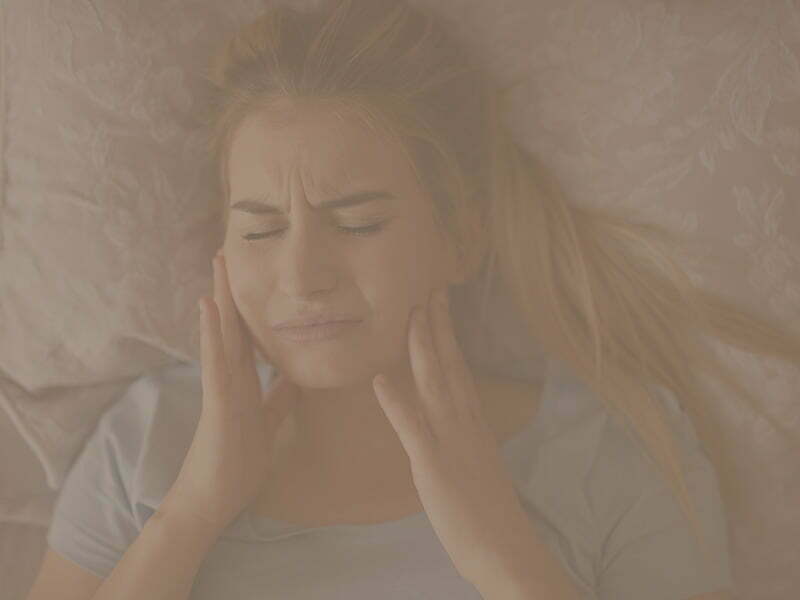

Every year, millions of people are diagnosed with migraine headaches. Often these headaches are caused by a disorder of the jaw joint causing improper jaw alignment.
Frequent moderate to severe headache pain occurring more than once a month may be related to Temporomandibular Joint Disorder (TMJD). Chronic migraine sufferers who have been unable to control their headaches with prescription drugs often find relief from TMJ therapies. Interestingly, several of the symptoms of migraine headaches are also symptoms of TMJD.
TMJ disorders occur due to misalignment of the jaws and teeth. The misalignment leads to intense pain as it causes displacement of the cartilage in the lower jaw and severe pressure on the nerves. Common symptoms of both TMJD and migraine diagnoses include chronic drug-resistant headaches, dizziness, neck pain, sensitivity to light, ringing in the ears, and generalised acute pain and tension of the head, jaw, neck, and shoulders. Some migraine patients have suffered for years and spent incredible amounts of money on MRIs, medications and countless other therapies with no relief. Some easy and inexpensive TMJ treatments often prove helpful in these cases.

Approximately 25% of the population has some variation of TMJ disorder. The majority of those are women of childbearing age. Most people who have TMJD go undiagnosed since their symptoms often mimic other conditions (such as migraines). Unfortunately, doctors often provide treatments that only address symptom control and do not correct the problem itself.
Pain – The most common symptom of TMJD is pain. The pain often begins as a mild ache in or near the jaw joint, ear, temple area, neck, and shoulders, and worsens over time as the actual structure of the joint can become damaged. Other signs include jaw, neck, and facial muscle stiffness or tension, a limited range of motion or “locking” of the jaw, painful popping or clicking in the jaw joint, ear pressure or pain, hearing problems, dizziness and vision problems.
Headaches – Chronic moderate to severe headaches are a major symptom of TMJ disorder. Headaches that are focused behind the eyes, near the temples, around the jaw and ears, or at the back of the head in the area of the neck and shoulders are generally TMJ-related, as is generalised severe pain affecting the entire head and/or neck.
Occasional discomfort of the jaw joint or muscles is not uncommon and is not usually cause for alarm. However, severe pain that doesn’t go away on its own over time or by treatment with over-the-counter pain relievers should be examined by a doctor. Speak with your doctor or dentist about your symptoms and how they relate to the possibility of TMJD.
There is currently no standard test for diagnosing TMJD. A doctor will examine your head, face, neck, and jaw, consider your symptoms, may provide tests to rule out other possible causes, and can provide useful information and advice. A diagnosis may not be possible until every other possibility has been rejected.

Your dentist is qualified to diagnose and treat a range of TMJ disorders and can provide information and professional advice. A thorough dental examination can help you and your dentist focus on the most promising treatment plan for relieving TMJ related headaches.
There are many options for treating TMJ-related pain and headaches. Most of them are easy and free or very inexpensive, and are worth a try for easing severe headache pain that won’t respond to other treatments.
Mouthguard – One of the main causes of TMJ headache pain is teeth-grinding, which tends to occur most often at night. A mouthguard worn when you sleep to help stop grinding and clenching your teeth. The mouthguard or splint can be soft or hard.
Stretching – Stretching and strengthening exercises for the jaw muscles are also helpful. Stretch your jaw by opening it as wide as you can several times throughout the day. Stretching of the entire upper body area is recommended: focus on neck, arms and shoulders. Paying attention to good posture will help relieve pain as well.
Lowering stress levels – Stress compounds the TMJ headache issue by causing muscle tension and fatigue. Stress also causes most TMJ sufferers to clench and grind their teeth more frequently, and clenching is a main cause of headaches. Try to cultivate an awareness of your stress level and be sure you aren’t unconsciously clenching during times of stress, frustration, or exhaustion. Try a hot bath, deep breathing, yoga, meditation, or a nap; these are all effective stress-relievers.
Massage – Massage can be extremely helpful in reducing tension and loosening tight muscles. Gently press on the areas around the jaw including the shoulders, neck and face. This will help you locate the painful areas. Using firm, short strokes, massage these areas several times a day for a few minutes each time. Focus on the muscles located on each side of the jaw by placing your thumb inside your mouth and pressing on the muscle located at the jaw joint in the back of the mouth. Use your index finger to massage the same spot on the outside of the mouth.
Diet – Small dietary changes can also produce major TMJ relief. The consistency of the foods you eat has a direct effect on TMJ pain. Try not to overwork your jaw muscles by eating chewy or hard foods or candies, and discontinue chewing gum. Chew as little as possible and try to eat only soft foods for a period of time to relieve jaw tension.